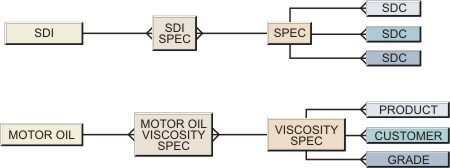A "Specification" is a set of numerical limits and rules against
which entered data are checked to provide an indication of the "quality"
of entered data. Two methodologies are available to check data against a Specification:
Spec Limit Checking is conducted at the Data Item level by comparing entered
data to a set of Specification Limits, each of which indicates a "Spec
Condition". When the data value falls with a Specification Limit, the corresponding
Spec Condition is reported.
| Data
Entry
|
|
Items
Evaluated During Spec Limit Checking
|
| Sample
|
Data Set
|
Parameter
|
Data Value
|
|
Specification
Limit
|
Spec Condition
when Data Value is withing Specification Limit
|
| Sample-001 |
Metals |
Au |
7.2 |

|
Au < 10 |
Out of Spec |
| |
|
Al |
41.4 |

|
Al > 30 |
Out of Spec |
| |
|
Ni |
12.6 |

|
10 ≤ Ni ≤ 15 |
Warning |
| |
|
Fe |
27.9 |

|
30 ≥ Fe > 25 |
Warning |
| |
|
Pt |
19.5 |

|
15 ≤ Pt ≤ 25 |
In Spec |
Spec SDI Checking begins by performing Spec Limit Checking as shown above.
Next, all Spec Conditions generated for the SDI are used to analyze one or more
Specification Rules. The Specification Rules determine the "SDI Condition",
which indicates the quality of all data entered for the SDI.
|
|
|
|
Spec Limit Checking Process
|
|
|
|
|
|
This example shows how Spec Limit Checking is conducted. At the Data Item level,
entered data are compared to the numerical Specification Limits. When entered
data falls within these limits, the "Specification Limit Type" defines
a "Spec Condition", which is reported to indicate where the data falls
(such as "Out of Spec" or "In Spec").
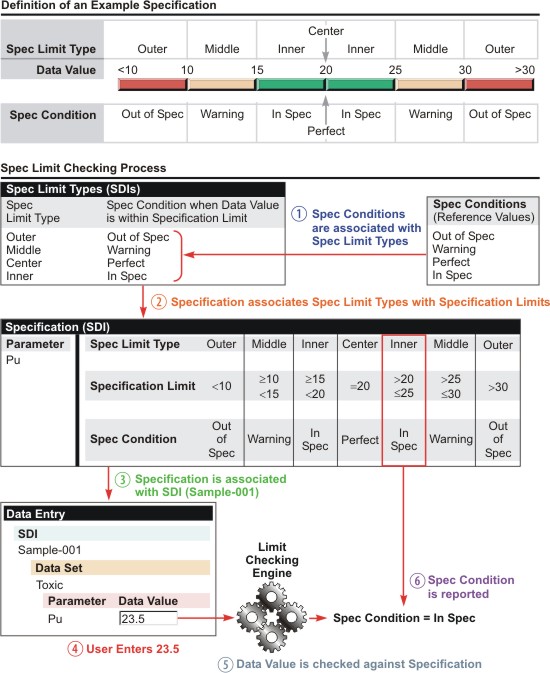
| 1.
|
Spec Conditions are associated with Spec Limit Types:
| • | The "Spec Condition" is a Reference Type used as a label
to indicate the quality of an entered data value. A single Spec Condition
is reported for each entered data value. | | • | The "Spec Limit Type" is an SDI used to determine how
the Spec Condition is reported during Data Entry (also see Note 1). |
|
| 2.
|
In the Specification, Spec Limit Types are associated with Specification
Limits:
| • | The "Specification" is an SDI that defines Specification
Limits and associates Spec Limit Types with Specification Limits. | | • | The "Specification Limit" defines a range of values against
which entered data are checked (also see Note 1). |
|
| 3.
|
The Specification is associated with the SDI. |
| 4.
|
Data are entered. |
| 5.
|
The data value is checked against the Specification. |
| 6.
|
The Spec Condition is reported. |
| Note 1: |
Limit Type SDCs are also used to define Parameter Limits.
When you add a Limit Type SDI, the Limit Type Maintenance Page offers a
choice of whether you want to apply the Limit Type to Parameters or Specifications.
To distinguish from Parameter Limit Types, this documentation uses the term
"Spec Limit Type" to describe Limit Types that define Specifications.
In the illustration above, the "Outer" Spec Limit Type identifies
a Spec Condition of "Out of Spe"c when a Data Value falls within
a Specification Limit. |
| Note 2: |
In the example above, the Spec Limit Type "Outer"
will indicate a Spec Condition of "Out of Spec" when the Data
Value is less than 10 or greater than 30. |
To summarize, here is what you must do prior to entering data for the SDI:
| a. |
Enable the Allow Specifications option for the SDC relevant to the SDI
for which you will enter data. |
| b. |
Add Spec Conditions. |
| c. |
Add Spec Limit Types (Limit Type SDIs for use in Specifications rather
than Parameter Limits).
Associate a Spec Condition with each Spec Limit Type. |
| d. |
Add a Specification SDI. In the Specification Maintenance Page:
| 1. | For each Parameter you want to check, associate each Specification
Limit with a Spec Limit Type. | | 2. | Enter the Specification Limits. After you have entered the
limits, you can view or hide some of the limit information displayed
by the Specification Maintenance Page by re-entering the Limit Type
Maintenance Page and exercising these display options. |
|
| e. |
Add the Specification (and Data Set containing the relevant Parameter)
to the SDI for which you will enter data. |
|
|
|
|
Spec SDI Checking Process
|
|
|
|
|
|
After the Spec Limit Checking process has determined a Spec Condition for each
Parameter, the check can be further extended by applying "Specification
Rules". These are conditional statements that use the Spec Conditions of
individual Parameters to determine an "SDI Condition", thus providing
an indication of all data entered for an SDI.
There are currently two types of engines that process Specification Rules:
| |
Rules Engine
|
Usage
|
|
|
Expression-Based |
Expression-Based Rules are no longer supported. This document describes
them only to provide a reference for users of LabVantage 5.2 and earlier
who must transition from LVX/Jaguar. |
|
|
Banded
Structured |
These rules work with any supported Application Server. |
As an example, consider entering a Data Value for each of two Parameters (Al
and Fe). Both Parameters belong to the Metals Parameter List, a single
instance (Data Set) of which is assigned to SDI_001. You want to determine an SDI
Condition to get an indication of all data for the SDI.
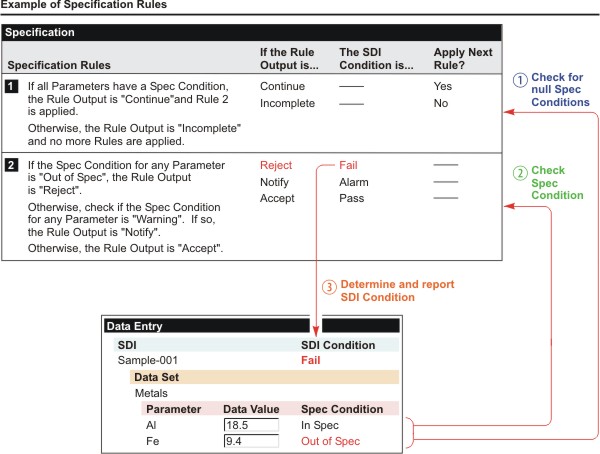
The illustration above shows how the entire process works. The table
below shows how you could define these Specification Rules under the Rules tab
of the Specification Maintenance Page.
| Rule |
Specification Rule Syntax and Meaning
|
Rule Output |
SDI Condition1 |
Stop |
| 1 |
if( ConditionsComplete(), "Continue", "Incomplete")
If all Parameters have a Spec Condition, the Rule Output is "Continue"
and Rule 2 is applied. Otherwise, the Rule Output is "Incomplete"
and no more Rules are applied. |
Continue |
None |
No |
| Incomplete |
None |
Yes |
| 2 |
if( ConditionExists( "Out of Spec" ), "Reject",
if( ConditionExists( "Warning" ), "Notify", "Accept"))
If the Spec Condition for any Parameter is "Out of Spec", the Rule Output
is "Reject". Otherwise, check if the Spec Condition for any Parameter
is "Warning"; if so, the Rule Output is "Notify". Otherwise, the
Rule Output is "Accept". |
Reject |
Fail |
No |
| Notify |
Alarm |
No |
| Accept |
Pass |
No |
1 The Specification Maintenance Page uses the term
Spec Condition to refer to the SDI Condition. You define SDI Conditions
the same way you define Spec Conditions, i.e., they are Reference Values you
define in the Spec Condition Reference Type.
During execution:
| • |
Rules are applied in the order listed. |
| • |
Each Rule returns a Rule Output that you define within the Rule. |
| • |
For each Rule, the Rule Output determines the SDI Condition reported. |
The above example assesses individual Spec Conditions for each Parameter as
follows:
| 1. |
Rule 1 determines if all Parameters have a Spec Condition. Spec
SDI Checking requires that all Parameters being checked have an associated
Spec Condition. Absence of a Spec Condition generally indicates that
data have not been entered for that Parameter. |
| |
a. |
If all Parameters have a Spec Condition, Rule 1 returns a Rule Output
of Continue. Since this Rule Output serves only to continue the checking
process, a Rule Output of Continue does not generate an SDI Condition.
Since the Stop option is disabled, the process continues and applies Rule
2. |
| |
b. |
If any Parameter does not have a Spec Condition, Rule 1 returns a Rule
Output of Incomplete. Since no Spec Conditions have been checked,
a Rule Output of Incomplete does not generate an SDI Condition. Since
the Stop option is enabled, no further Rules are applied. |
| 2. |
Rule 2 determines if the Spec Condition for any Parameter is Out of Spec
or Warning. |
| |
a. |
If a Spec Condition is Out of Spec, Rule 2 returns a Rule Output of Reject.
A Rule Output of Reject generates an SDI Condition of Fail. |
| |
b. |
If a Spec Condition is Warning, Rule 2 returns a Rule Output of Notify.
A Rule Output of Notify generates an SDI Condition of Alarm. |
| |
c. |
If no Spec Condition is Out of Spec or Warning, Rule 2 returns a Rule
Output of Accept. A Rule Output of Accept generates an SDI Condition
of Pass. |
As an example, suppose you set your Specification Limits to indicate the following
Spec Conditions:
| Spec Conditions: |
In Spec 15 <= x <= 25 |
|
Warning 5 < x < 15 |
|
Out of Spec 0 <= x <=
5 |
When you enter data, and as you change it, the two Rules in the previous
example should yield the following
results:
| Parameter |
Data Value |
Spec Condition |
Rule Output |
SDI Condition |
| Al |
18 |
In Spec |
Rule 1: Incomplete
Rule 2: (none) |
(none) |
| Fe |
|
|
| Fe |
3 |
Out of Spec |
Rule 1: Continue
Rule 2: Reject |
Fail |
| Fe |
10 |
Warning |
Rule 1: Continue
Rule 2: Notify |
Alarm |
| Al |
20 |
In Spec |
Rule 1: Continue
Rule 2: Accept |
Pass |
Specification Rules do nothing more and nothing less than you tell them.
You must account for all possibilities that can occur during a Data Entry session.
In general, check for the following occurrences in the order specified:
| 1. |
Check for Spec Conditions
Parameters without Spec Conditions indicate that Spec Limit Checking was
not conducted, usually because data have not yet been entered. Erroneous
results are returned if you do not check for missing Spec Conditions.
In the example above, Rule 1 performs this check. |
| 1. |
Check for Spec Conditions from Worst to Best
Begin Check for worst-case Spec Conditions, working your way toward best
(such as Rule 2 in the example above). |
After these rudimentary checks, you can perform more specific or advanced checking
if required.
Banded
and Structured Rules
|
|
These are easier to use than Expression-Based Rules.
Recall from the previous discussions that, when using Specification Rules:
| • |
Spec Limit Checking is conducted first. This compares entered data to
a set of Specification Limits, each of which indicates a Spec Condition.
When the data value falls with a Specification Limit, the corresponding
Spec Condition is reported. |
| • |
Spec SDI Checking begins by performing Spec Limit Checking. Then, all
Spec Conditions generated for the SDI are used to analyze one or more Specification
Rules. The Specification Rules determine the SDI Condition, which
indicates the quality of all data entered for the SDI. |
Banded Rules cover the most basic case. Multiple "bands" can be specified,
with the final band being the default condition. Here's an example:
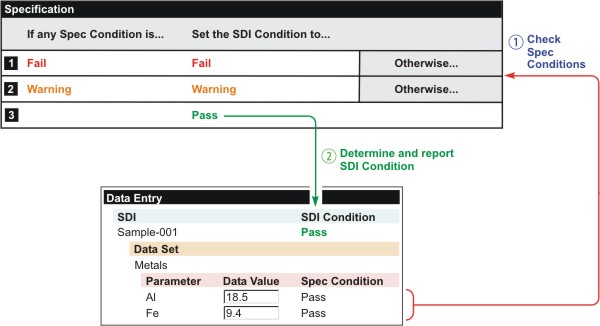
Structured Rules let you create multiple rules, each defining a series of conditions
according to fixed grammar. The Rules Engine processes each rule individually,
stopping after it processes a rule that returns true. Example:
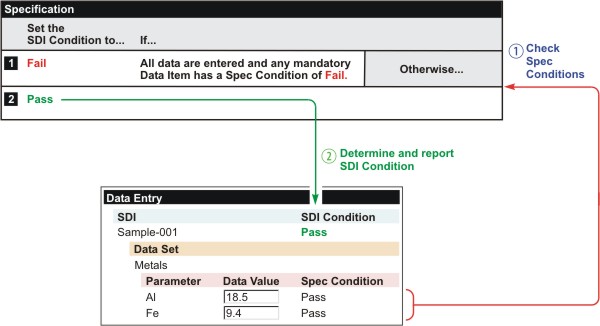
Unlike Banded Rules, a default condition is not necessary. However, one can
be specified as shown in the above example.
Linking Specifications to other SDCs
|
|
The Specification SDC (SpecSDC) is a System SDC, thereby letting you add
columns and link it to any other SDC. You can relate a Specification
to SDIs by creating an SDC Link from a Specification column to the relevant
SDC.
The two models below show the relationship. The first generic model shows
how SDIs "own" a Specification. The second model is an example
of how Motor Oil can be checked against the Viscosity Spec, which has the
columns Product, Customer, and Grade. Using three SDC Links, the Viscosity
Spec applies to SDIs in the SDCs Product, Customer, and Grade.
